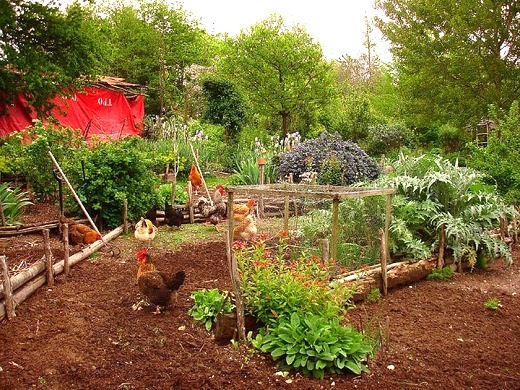SUBHEAD: Archeological evidence indicates civilization preceded the agriculture contradicing the idea agricultural made civilization possible.
By Stuart Jeane Bramhall on 26 August 2013 in Dissident Voice -

Image above: Permaculture in action. Photo credit: hardworkinghippy via photopin cc. From (http://stuartbramhall.aegauthorblogs.com/2013/08/26/a-roadmap-to-redesigning-civilization/).
Toby Hemenway, host of the video Redesigning Civilization — with Permaculture, defines permaculture as a branch of ecological design that employs natural ecosystems as a model. Although most permaculture design relates to food production, its principles can be applied to the management of all human needs, including water, shelter, waste, energy, finance, culture/spirituality and even sports and security.
Permaculture-based food production focuses on returning to a “horticultural” method of food production with “food forests” and other self-maintained food systems, as opposed to our current mechanized, open field method of food production. Permaculture relies on ecologically designed gardens, rather than open fields, and mixed crops, rather than monoculture. It also employs the continuous plant succession typical of natural ecosystems, rather than starting with a clear cut every year.
For me, the most interesting part of the film is Hemenway’s discussion of archeological evidence that civilization preceded the Agricultural Revolution (around 10,000 BC). This contradicts the prevailing belief that the agricultural made civilization possible by creating a food surplus. It’s been argued for more than a century that the creation of a food surplus through open field agriculture freed up non-farmers to specialize in higher pursuits, such as art, science, music, religion, and literature.
According to Hemenway, more recent archeological evidence suggests that civilization came first. This includes Venus figurines which have been discovered from 40,000 years ago, religious symbols from 30,000 years ago, evidence of horticulture (plant tending) 30,000 years ago and evidence of irrigation 20,000 years ago. He also talks about an archeological site in Gokikli Tepi Turkey from 14,000 years ago that reveals that our ancestors were attending large spiritual gatherings of hundreds of people.
Feeding large numbers of people simultaneously poses a clear technological challenge. Hemenway suggests that these large gatherings may have been the impetus for large scale open field cultivation. “Agriculture” (from “ager” meaning field) made it possible to produce large amounts of grain which, unlike other foods, can be stored for long periods.
Hemenway goes on to discuss some of the immediate drawbacks of grain-based agriculture (based again on archeological evidence):
- Overpopulation, famine, and warfare – agriculture immediately caused a population boom, as grains are the one of the easiest foods to convert to calories. They increase female fertility, as well as allowing for early weaning (breast feeding inhibits ovulation). This population boom made settlements more susceptible both to conquest from neighboring tribes and famine due to failed harvests.
- Shorter life span and poorer health – following the introduction of agriculture, people tended to be shorter, suffer from more degenerative disease, and have shorter life spans (by about 20-30%). They also became subject to deadly viral epidemics (such as small pox) transmitted from domesticated animals.
- Less leisure time – following the introduction of agriculture, people had to work 60+ hour weeks just to survive. This was in part due to the need to support a priesthood, nobility, and military to protect the grain surplus. A hunter gatherer can generally collect sufficient food in four hours to last him a week.
- Agriculture created a fear of nature (of insects, weeds, wilderness, wild animals, and wild people) and a mindset in which people came to see themselves as separate, rather than part of nature.
Hemenway goes on to outline the basic permaculture design principles, with specific examples of their application to all aspects of sustainable living:
- Catching, storing, and reusing energy and materials, essentially eliminating the concept of waste.
- Becoming pattern literate – learning to observe ecosystems to see how a small change can have a big effect.
- Focusing on community and regional self-reliance rather than individual self-sufficiency.
Enjoy.
Video above: Toby Hemenway presents "Redesigning Civilization - with Permaculture", One hour, thirteen minutes. From (http://youtu.be/H6b7zJ-hx_c)
• Dr. Stuart Bramhall is an American child and adolescent psychiatrist and political refugee in New Zealand. Her works include a young adult novel The Battle for Tomorrow about a 16 year old girl who participates in the blockade and occupation of the US Capitol and a memoir, The Most Revolutionary Act: Memoir of an American Refugee. Email her at: stuartbramhall@yahoo.co.nz. Read other articles by Stuart Jeanne.
.
No comments :
Post a Comment